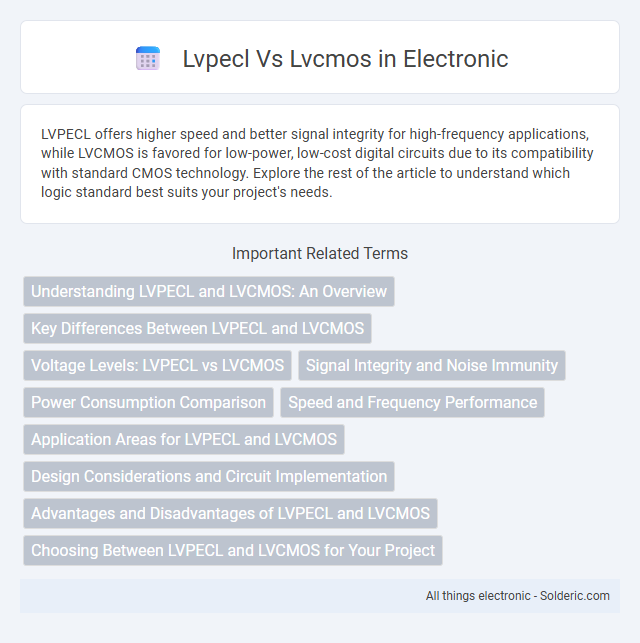LVPECL offers higher speed and better signal integrity for high-frequency applications, while LVCMOS is favored for low-power, low-cost digital circuits due to its compatibility with standard CMOS technology. Explore the rest of the article to understand which logic standard best suits your project's needs.
Comparison Table
| Feature | LVPECL (Low Voltage Positive Emitter Coupled Logic) | LVCMOS (Low Voltage CMOS) |
|---|---|---|
| Signal Type | Differential | Single-ended |
| Voltage Levels | Typically 1.6V to 2.0V differential | 1.2V to 3.3V depending on standard |
| Speed | High speed, up to several GHz | Medium speed, typically up to hundreds of MHz |
| Power Consumption | Higher power due to constant current operation | Lower power, CMOS static power consumption |
| Noise Immunity | Excellent due to differential signaling | Lower, more susceptible to noise |
| Applications | High-speed clock distribution, high-frequency signaling | General purpose digital logic, microcontrollers |
| Drive Capability | Requires differential pair, termination resistors | Single pin drive, easier PCB routing |
Understanding LVPECL and LVCMOS: An Overview
LVPECL (Low-Voltage Positive Emitter Coupled Logic) offers high-speed signal transmission with low voltage swing and differential signaling, making it ideal for high-frequency applications. LVCMOS (Low Voltage Complementary Metal-Oxide-Semiconductor) operates with single-ended signals and lower power consumption, commonly used in general-purpose digital circuits. Understanding these differences helps you select the appropriate logic family based on speed, power efficiency, and noise immunity requirements.
Key Differences Between LVPECL and LVCMOS
LVPECL (Low Voltage Positive Emitter Coupled Logic) operates with differential signaling, providing higher speed and better noise immunity compared to LVCMOS (Low Voltage Complementary Metal-Oxide-Semiconductor), which uses single-ended signaling suited for lower power and simpler interfacing. LVPECL typically requires controlled impedance transmission lines and termination resistors, making it ideal for high-frequency applications, whereas LVCMOS is more power-efficient and widely used in general-purpose digital logic circuits. Your choice between LVPECL and LVCMOS depends on the speed, power consumption, and signal integrity needs of your design.
Voltage Levels: LVPECL vs LVCMOS
LVPECL operates at differential voltage levels typically around 800 mV to 1 V, with common mode voltages near 2 V, enabling high-speed signaling and noise immunity. LVCMOS uses single-ended voltage levels ranging from 1.8 V to 3.3 V or higher, depending on the standard, suitable for lower-speed, low-power digital circuits. Your choice between LVPECL and LVCMOS voltage levels impacts signal integrity, power consumption, and system compatibility.
Signal Integrity and Noise Immunity
LVPECL (Low-Voltage Positive Emitter-Coupled Logic) offers superior signal integrity and noise immunity compared to LVCMOS (Low-Voltage Complementary Metal-Oxide-Semiconductor) due to its differential signaling which reduces electromagnetic interference and crosstalk. LVPECL's constant current operation and differential output provide better jitter performance and lower susceptibility to common-mode noise, making it ideal for high-speed data transmission. In contrast, LVCMOS uses single-ended signaling, which is more prone to noise and signal degradation in electrically noisy environments.
Power Consumption Comparison
LVPECL (Low-Voltage Positive Emitter-Coupled Logic) consumes significantly more power than LVCMOS (Low-Voltage Complementary Metal-Oxide-Semiconductor) due to its differential signaling and constant current draw. LVCMOS outputs operate with lower static power dissipation, making them ideal for energy-sensitive applications. If minimizing Your device's power consumption is critical, selecting LVCMOS typically offers superior efficiency over LVPECL.
Speed and Frequency Performance
LVPECL (Low-Voltage Positive Emitter-Coupled Logic) offers superior speed and frequency performance compared to LVCMOS (Low-Voltage Complementary Metal-Oxide-Semiconductor), supporting frequencies up to several gigahertz with low jitter and fast rise times typically in the sub-nanosecond range. LVCMOS is generally limited to lower frequencies, often below 500 MHz, due to its CMOS transistor switching characteristics resulting in slower transitions and higher propagation delays. The differential signaling of LVPECL minimizes noise and crosstalk, enabling higher signal integrity at high frequencies, whereas LVCMOS's single-ended signals are more susceptible to noise, affecting reliable operation at elevated speeds.
Application Areas for LVPECL and LVCMOS
LVPECL is widely used in high-speed communication systems, clock distribution, and networking equipment due to its fast switching speeds and low jitter characteristics. LVCMOS is preferred in general-purpose digital circuits, microcontrollers, and FPGA interfaces where low power consumption and compatibility with standard CMOS logic levels are essential. Your choice depends on the need for speed and signal integrity versus power efficiency and system compatibility.
Design Considerations and Circuit Implementation
LVPECL offers superior signal integrity for high-speed designs due to its differential signaling and low noise characteristics, making it ideal for applications requiring minimal jitter and electromagnetic interference. LVCMOS, with single-ended signaling and simpler circuitry, provides lower power consumption and easier implementation in low-speed, cost-sensitive environments. Your choice between LVPECL and LVCMOS should balance the need for high-speed performance against power efficiency and circuit complexity.
Advantages and Disadvantages of LVPECL and LVCMOS
LVPECL offers high-speed performance and low jitter, making it ideal for high-frequency clock distribution but consumes more power and requires differential signaling, increasing complexity. LVCMOS operates at lower power with single-ended signaling for simpler PCB design, though it has limited speed and higher susceptibility to noise and signal integrity issues. Choosing between LVPECL and LVCMOS depends on the trade-off between power consumption, signal integrity, and speed requirements in the application.
Choosing Between LVPECL and LVCMOS for Your Project
Choosing between LVPECL and LVCMOS depends on your project's speed, noise immunity, and power consumption requirements. LVPECL offers high-speed signals with low jitter and strong noise immunity, making it ideal for high-frequency applications, while LVCMOS provides lower power consumption and simpler interfacing, suitable for general-purpose digital circuits. Evaluate your design's operating frequency, voltage levels, and electromagnetic environment to select the driver that best optimizes performance and reliability.
lvpecl vs lvcmos Infographic

 solderic.com
solderic.com